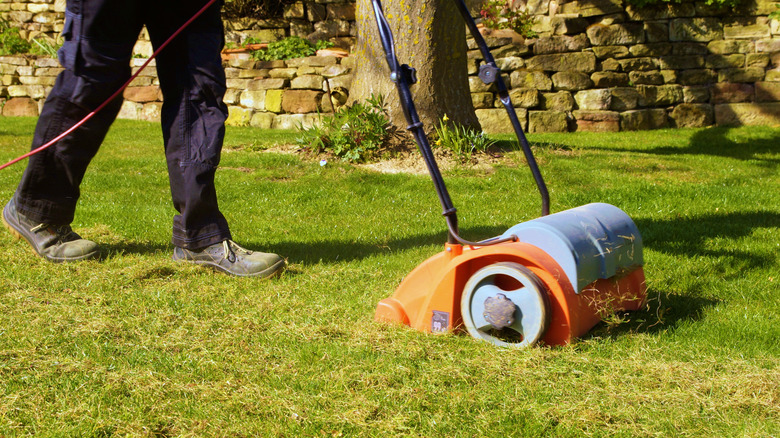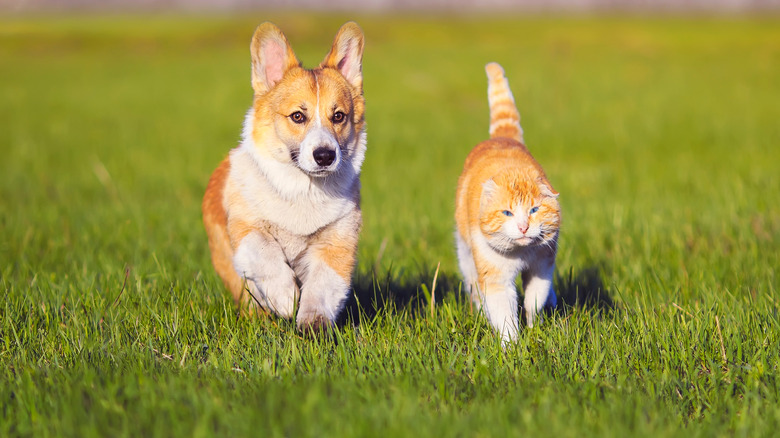Even though they’re delicious in soups and sauces, the presence of mushrooms in your lawn isn’t always a welcome sight. Whether they only seem to appear after a heavy rainfall or you’re constantly battling them because your yard is shady, there are six ways you can tackle the fungi problem once and for all.
While they may be a thorn in your side for throwing off the aesthetics of your lush, green lawn, most mushrooms that grow in suburban yards are harmless. Sometimes they’re even beneficial because they can improve your soil by depositing nutrients as they decompose. However, there are at least 10,000 types of mushrooms in nature, per Mushroom Appreciation, so this can bring up concerns about poisonous mushrooms — especially if you have curious children or pets who may be tempted to take a bite of the spongy exteriors. If this is a worry of yours, read on for six different ways to get rid of mushrooms in your lawn.
1. Aerate the soil

Do you have areas in your yard where water always collects and it takes a long time to dry up? Or maybe you don’t see standing water, but there’s a section that always feels squishier and muddier than other parts of the lawn? If so, this could mean that your soil is compacted. What does this have to do with the fungi population? Mushrooms absolutely thrive in damp conditions, so if sections of your lawn are always soggy, that’s a heavenly atmosphere for them.
According to Gardening Know How, you can use an aerator machine to do the work for you. Depending on the specific type of machine, it will either pull out plugs of soil or poke holes into the dirt so that it can settle more evenly. If you don’t want to rent a machine, you can pick up a pair of lawn spike shoes to wear. Scotts points out that aeration will help with moisture problems in the yard, while also increasing oxygen flow so it can better reach the roots of your grass.
2. Keep the grass short
While it’s detrimental to the health of your grass if you cut it too short, you also don’t want to let it grow too long. Instead, try to strike a happy balance with the length. As we’ve already discussed, moisture and mushrooms go hand-in-hand. So when your grass is too long, it’s harder for the sunlight to reach the soil and help dry it out. If the grass and soil remain in this damp, semi-dark limbo condition, it won’t take long for mushroom spores to spread and sprout. Air circulation is more difficult in long, thick grass, so more air means dryer conditions and healthier root systems.
When it comes to lawn clippings, it’s advisable to leave some behind after mowing to nourish and protect your grass. However, leaving behind a layer that’s too thick can encourage mushroom growth, says Bob Vila. You should also get into the habit of dethatching your lawn — especially in areas where mushrooms are present — to prevent additional moisture problems.
3. Remove mushrooms by hand
Shutterstock
You may think the easiest solution for getting rid of mushrooms is to mow over them as you’re cutting your grass. While this method certainly provides an instant improvement in terms of aesthetics, you might want to reconsider it. According to Lawn Chick, running over mushrooms with a mower can actually spread the spores throughout your yard. So instead of having a small (and controllable) area with a mushroom problem, you may now have a much larger problem throughout your entire lawn.
Instead of mowing, a better option is removing the mushrooms by hand. Make sure to put on gardening gloves first, and then you can either pull them out of the ground or use a knife to cut them out. If your yard has lots of mushrooms, Bob Vila suggests pulling them out as soon as they appear. Otherwise, mushrooms only need a little window of time to release their spores and perpetuate the cycle.
4. Don’t water at night
Shutterstock
Watering your lawn at night seems like a great idea, in theory. You don’t have to bake in the sun, you won’t need to use as much water, and it’ll give your grass more time to absorb the water. Unfortunately, the reality is that watering at night creates the most perfect conditions for mushroom growth: a dark, damp, cool environment.
Without the sunshine, the water will sit on your grass and not evaporate as quickly. This is especially true if you live in a particularly humid region. With that being said, if you live in an extremely dry area, you might not experience this problem and can experiment with nighttime watering to see if it causes fungal issues.
Overall, the best time to water your lawn is in the early morning, before 9:00 a.m., says Lawn Doctor. This will give the grass time to absorb the water before evaporation issues arise with the hot, midday sun. You may even save on your water bill since you likely won’t need to use as much water.
5. Use nitrogen fertilizer
Shutterstock
Mushrooms get their nutrients from decomposing organic material in the soil. Because of this, a nitrogen-based fertilizer may help in your battle against the fungi in your lawn. Why nitrogen? According to Troy-Bilt, it helps speed up the decomposition process by breaking down the organic material more quickly. If there’s not an abundance of organic material present, mushrooms won’t grow there.
Troy-Bilt suggests spreading 1/2 pound of fertilizer per 1,000 square feet of lawn. You can find nitrogen-based fertilizer at any garden center or home improvement store. It’s important to follow the package instructions exactly, and dilute as directed; if you skip over this and apply too much, you can burn your lawn.
When applied correctly, the fertilizer will make the mushrooms go away more quickly and not return as easily. It’s not an immediate fix, so be patient. Additionally, if you have other issues in your lawn like moisture and light problems but don’t address them, the fertilizer won’t have much chance to work.
6. Clean up after your pets

Bachkova Natalia/Shutterstock
While there’s no denying that our fluffy friends are treasured, beloved members of our families, they might be contributing to your lawn’s mushroom problem. As we previously discussed, mushrooms rely on decomposing organic material in the soil to provide their nourishment.
Let’s say Fido has a specific area in your yard where he does his business and you leave that corner untouched. The high concentration of decaying organic material in Fido’s section will be too enticing for mushrooms to pass up. It’s not a pleasant task, but if you invest in a high-quality pooper scooper, it might make the process more bearable — especially if Fido won’t agree to wearing a doggy diaper.
Garden Seeker says that your best plan of attack is to scoop up pet waste as soon as you can so it doesn’t have time to begin breaking down into the soil. Since you’ll already be picking up things, Garden Seeker also advises that you get into the habit of cleaning up any leaf piles once a week, as their decomposition provides another source of yummy mushroom food.


